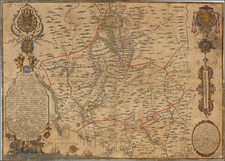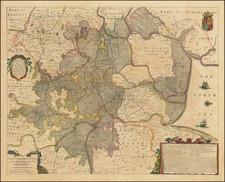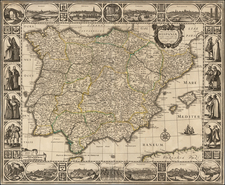Rare Map and View of Gibraltar Showing the Fortified Peninsula During the War of Spanish Succession
Striking map of Gibraltar and its environs, paired with a birds-eye view, published by Pierre Husson (1678-1733).
The top portion of the broadside shows the intimidating rock of Gibraltar. The town is laid out at the foot of the outcrop. Some of the many fortifications are shown, particularly the batteries to the north, protecting the settlement from landside invasion. Several key points are marked with letters that are explained in the cartouche to the upper right.
The map below shows the towns and terrain to the west of Gibraltar. The city itself is clustered on its thin strip of land to the east; the buildings are shown in perspective, as are docks, mills, watchtowers, military entrenchments, artillery emplacements with range lines of fire, roads, working lands and masses of trees. Two fleets of ships are shown lining up for battle and firing at each other. They represent the opposing sides in the War of Austrian Succession (1701-1714); this particular battle was part of the Twelfth Siege of Gibraltar in 1704-5.
Gibraltar—a strategic crossroads
Gibraltar guards the entrance to the Mediterranean and is the narrowest point between Europe and Africa. This position makes it a strategic asset to whomever controls the Rock and Gibraltar’s history is riddled with handovers, battles, and invasions.
The Vandals took Gibraltar after the fall of the Western Roman Empire and it was part of the Visigoth Kingdom of Hispania from 414 to 711 AD. In that year, a Berber army from North Africa crossed the strait; they took possession of Gibraltar and, eventually, the majority of the Iberian Peninsula. They called the feature Jebel Tariq, which was later corrupted into Gibraltar.
In 1160, the Almohad Sultan Ahd al-Mu’min decided that the area needed additional protection and ordered that a fortress be built overlooking the Bay of Gibraltar. The castle, Medinat al-Fath, or City of Victory, still has a tower standing today and is most likely the tower shown to the north (left) of the plan shown on the top of the sheet, just up the hill from the marker “B”.
From the thirteenth century onwards, the peninsula shifted hands several times (1237, 1274, 1309, 1333, 1374, 1462). The last of these, the retaking of Gibraltar by Juan Alonso de Guzmán, 1st Duke of Medina Sidonia, was part of the Catholic Reconquest of the Iberian Peninsula. The Rock remained in either Crown or noble hands (expect for two years when the Duke of Medina Sidonia sold it to a group of conversos, or Jews who converted to Christianity, who were then expelled) for the sixteenth and seventeenth centuries.
In early August1704, an Anglo-Dutch fleet sailed toward Gibraltar. They were part of the Grand Alliance that formed to resist Louis XIV’s attempt to instill his grandson on the throne of Spain. After four days of battle commencing 1 August, they captured Gibraltar. This triggered the Twelfth Siege of Gibraltar, whereby French and Spanish troops attempted to wrest control of the peninsula back from the British, Dutch, and their Hapsburg allies. The siege was led by the Marquis de Villadarias; his camp is shown with a red stripe to the north of the peninsula on the bottom portion of this sheet.
Villadarias spent the end of the 1704 and the beginning of 1705 attempting to take back Gibraltar. Ultimately, he was replaced by the Marshal de Tessé. The French Marshal subsequently gave up the attempt to regain the Rock. In the Treaty of Utrecht of 1713, which ended the War of Spanish Succession, Gibraltar was ceded to Britain, who still controls the point today.
The page likely appeared in Variae tabulae geographicae in quibus luca in orbe bello flagrantia (1709), after the siege and before the signing of the Treaty of Utrecht. It represents an important moment in Gibraltar’s besieged history, when the British entrenched themselves on the peninsula. The survival of a sheet like this is quite rare and it would enliven a collection of military ephemera or Gibraltar maps.












![[ Wight ] Isle de Wigh](https://storage.googleapis.com/raremaps/img/small/98047.jpg)
![[ American Revolution - Satirical Warning To Dutch Commerce ] Den Door List en Geweld Aangevallen Leeuw.](https://storage.googleapis.com/raremaps/img/small/99580.jpg)
